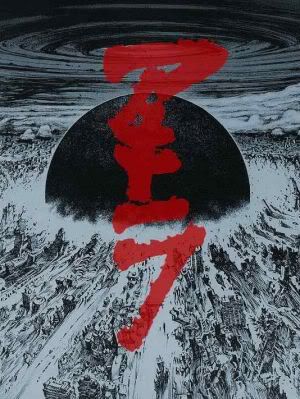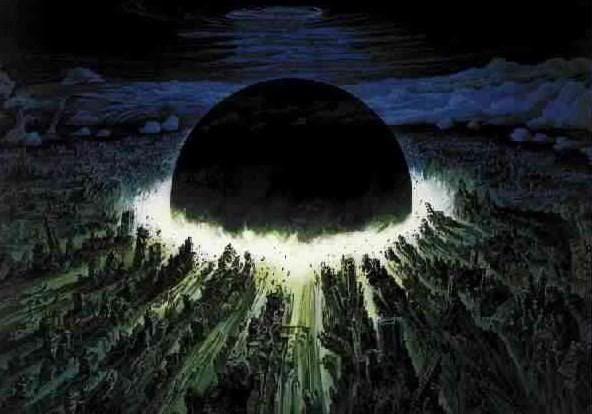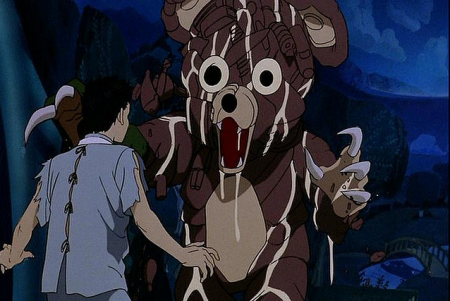 |
| Fig. 1 Akira Poster |
Akira, very basically, is a story of military and scientific power gone horribly wrong. They have begun meddling with a source of power much greater than they could have foreseen, inevitably losing control and their lives to it. One of the reasons that Akira is so poignant though is not just because it plays on people's fear of the unknown and uncontrollable, but the fear of past experiences.
 |
| Fig. 2 Obliteration of Neo Tokyo. |
The context in Japan, and many other western cultures, is the fear of teenagers and puberty. This potent period can lead to them becoming too violent, uncontrollable and unpredictable. Their body is metamorphosing, along with their mind, into something different and until adulthood is attained and balance is restored these teenagers can be volatile to those around them. Susan J. Napier explains that Otomo privileges "the notion of the adolescent body as a site of metamorphosis, a
metamorphosis that can appear monstrous both to the figure undergoing it
and to the outside world." (Napier, 2001:40) In Akira, the body of Tetsuo is literally reborn, physically, as a baby when his powers become too much for his body to control. This is a monstrous baby, of giant, disfigured proportions, but it can be seen as a physical manifestation of Tetsuo's rejection of the oppressive restrictions of society's adulthood and instead choosing to embrace immaturity and childhood, to his own demise. This can also be seen in the scene illustrated in figure 3, when Tetsuo is confronted by a child's toy, leaking milk from its pores, that turns from something cute and comforting, into something huge and ravenous.
From the milk bleeding out of these monstrous cuddly toys, to the rolling and rippling cloth in the wind, Akira is a great acheivement of animation. This was Otomo's directorial debut, and as it began as his graphic novel it was rightly so. Both the film and books show an elegant merging of sociocultural ideas and science-fiction genre conventions to make it as entertaining as it is culturally relevant. Jerry Beck went on to explain that "It is considered one of the greatest animated features of any country, and one of the greatest science-fiction features, animated or live-action. It is one of the seminal titles that introduced Japanese animation to America as worthwhile adult entertainment rather than just kids’cartoons." (Beck, 2007:7) As a representative of Japanese animation, Akira displays so much detail and movement in every shot that it can barely be classed as a traditional 'anime' cartoon. Instead, as Beck mentioned, it has managed to not only bring Japanese animation to America and its mainstream, but to adult audiences as well. This is an achievement that few western animations can take credit for, and for Beck to mention that it is one of the best sci-fi films animated or live-action proves how powerful the film is.
Figure 2: Akira (1988) Obliteration of Neo Tokyo. At: http://img.listal.com/image/1554116/450full-akira-screenshot.jpg (Accessed on: 13.02.12)
Figure 3: Akira (1988) Tetsuo VS. childhood. At: http://img.listal.com/image/1554116/450full-akira-screenshot.jpg (Accessed on: 13.02.12)
Bibliography
Beck, Jerry (2007) Animated Movie Guide: The Ultimate Illustrated Reference to Cartoon, Stop-Motion and Computer-Generated Feature Films. USA: Chicago Review Press.
Napier, Susan J. (2001) Anime from Akira to Princess Mononoke: Experiencing Contemporary Japanese Animation. USA: MacMillan Palgrave USA.
Shapiro, Jerome Franklin (2002) Atomic bomb cinema: the apocalyptic imagination on film. USA: Routledge.
From the milk bleeding out of these monstrous cuddly toys, to the rolling and rippling cloth in the wind, Akira is a great acheivement of animation. This was Otomo's directorial debut, and as it began as his graphic novel it was rightly so. Both the film and books show an elegant merging of sociocultural ideas and science-fiction genre conventions to make it as entertaining as it is culturally relevant. Jerry Beck went on to explain that "It is considered one of the greatest animated features of any country, and one of the greatest science-fiction features, animated or live-action. It is one of the seminal titles that introduced Japanese animation to America as worthwhile adult entertainment rather than just kids’cartoons." (Beck, 2007:7) As a representative of Japanese animation, Akira displays so much detail and movement in every shot that it can barely be classed as a traditional 'anime' cartoon. Instead, as Beck mentioned, it has managed to not only bring Japanese animation to America and its mainstream, but to adult audiences as well. This is an achievement that few western animations can take credit for, and for Beck to mention that it is one of the best sci-fi films animated or live-action proves how powerful the film is.
List of Illustrations
Figure 1: Akira (1988) Akira poster. At: http://www.movieposterdb.com/posters/05_05/1988/0094625/l_14946_0094625_2eb4ff00.jpg (Accessed on: 13.02.12)
Figure 2: Akira (1988) Obliteration of Neo Tokyo. At: http://img.listal.com/image/1554116/450full-akira-screenshot.jpg (Accessed on: 13.02.12)
Figure 3: Akira (1988) Tetsuo VS. childhood. At: http://img.listal.com/image/1554116/450full-akira-screenshot.jpg (Accessed on: 13.02.12)
Bibliography
Beck, Jerry (2007) Animated Movie Guide: The Ultimate Illustrated Reference to Cartoon, Stop-Motion and Computer-Generated Feature Films. USA: Chicago Review Press.
Napier, Susan J. (2001) Anime from Akira to Princess Mononoke: Experiencing Contemporary Japanese Animation. USA: MacMillan Palgrave USA.
Shapiro, Jerome Franklin (2002) Atomic bomb cinema: the apocalyptic imagination on film. USA: Routledge.



No comments:
Post a Comment